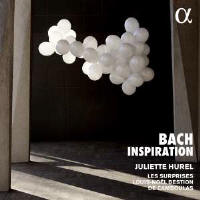Texte paru dans: / Appeared in: |
|
|
Reviewer:
Raymond Tuttle
This CD goes by the name
Inspiration. This is a nice touch, because “inspiration” also means, of
course, the drawing in of breath—an activity that is rather important for
flutists, even for the talented Juliette Hurel! Its contents are a
mini-survey of the several ways in which Bach used the flute: all by itself,
as a concertante instrument, as a participant in chamber ensembles, and as
an obbligato instrument in vocal music. As such, it is an imaginative and
gratifying program. The most curious item here is the last—the opening aria
from the cantata Ich habe genug. Performances by basses outnumber those by
sopranos, but the soprano version, while later, is Bach’s own. In the
original version, the bass is accompanied by an oboe. In the revised
version, the soprano is accompanied by a flute. This brings the CD to a
satisfying close. When talking about Bach, we tend to say that his music is
so wonderful that it can be effective on any instrument. We probably need to
emphasize that, when Bach specified an instrument, he knew what he was
doing!
The booklet does not tell us
what kind of flute Hurel is playing. On a Haydn disc that I reviewed in
Fanfare 41:2, she played a wooden flute. From its sound, my guess is that
she is playing a modern flute, and from the scattering of photos in the
booklet, it does not appear to be one made from metal. Whatever the case,
she blends well with her fellow instrumentalists in the Suite No. 2 and in
the G-Major Trio Sonata. As I noted in that Haydn review, and also in a
review of Mozart’s Flute Quartets (Fanfare 39:3), Hurel’s playing is on the
mellower end of the brilliance spectrum, although the Badinerie from the
Suite No. 2, for example, has the necessary sparkle. (I get startled each
time I hear this movement, because I programmed it as the ring tone on my
cell phone.) Although not showy, Hurel’s playing is exemplary, not least in
the Partita, where she stands by herself in the spotlight and shapes Bach’s
phrases and his overall structures with confidence.
Since she appears in four
arias, I cannot end this review without mentioning French soprano Maïlys de
Villoutreys. Hers is a new name to me, and she must be rather young, because
she completed her Masters of Music degree as recently as 2011. Despite her
bright timbre, she finds the appropriate weight for “Aus Liebe will mein
Heiland sterben” from the St. Matthew Passion and Ich habe genug, and she is
purely appealing in the other two arias. The conductor, who leads from the
organ or from the harpsichord, matches Hurel’s gentle and dignified
musicality. For flute lovers in particular, this is a lovely Bach CD, and a peaceful one too. | |
|
|
|
|
|
|
|
Cliquez l'un ou l'autre
bouton pour découvrir bien d'autres critiques de CD |
|




